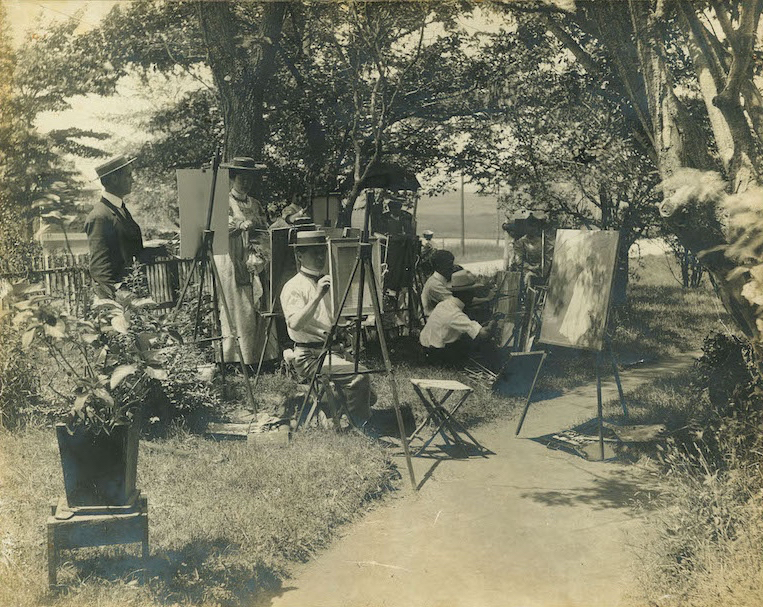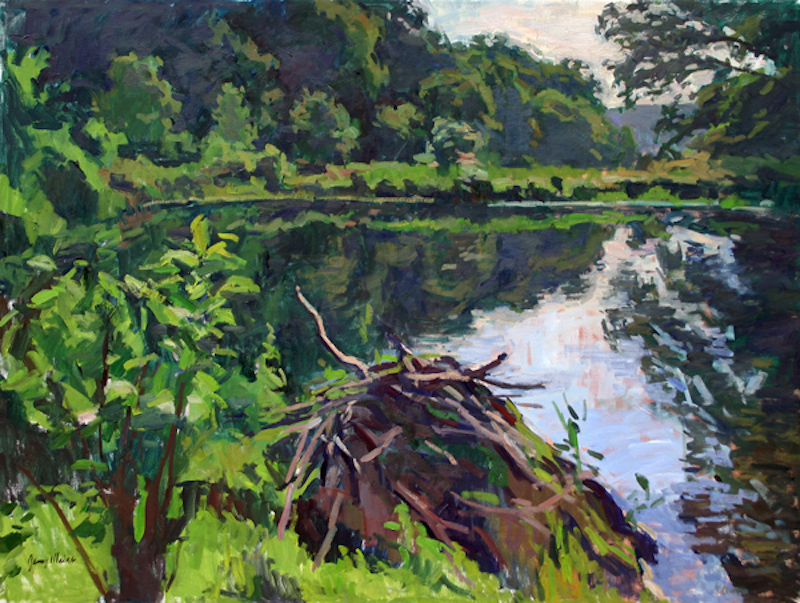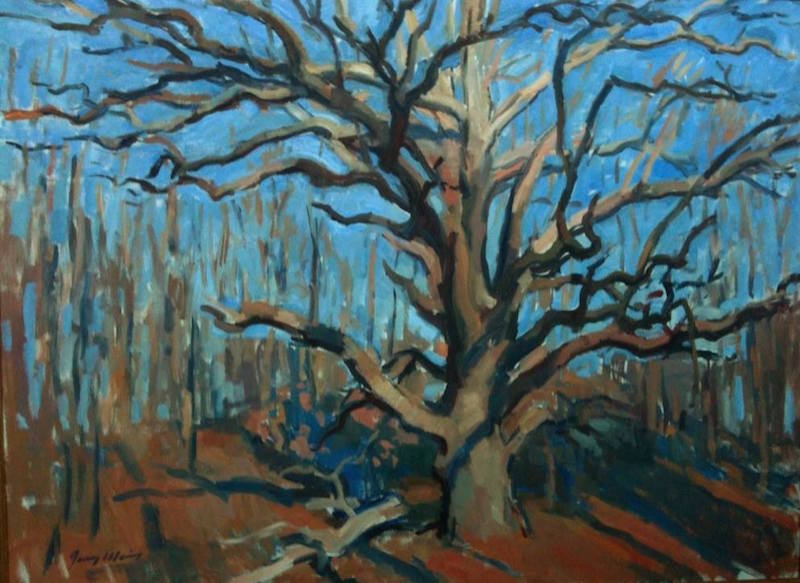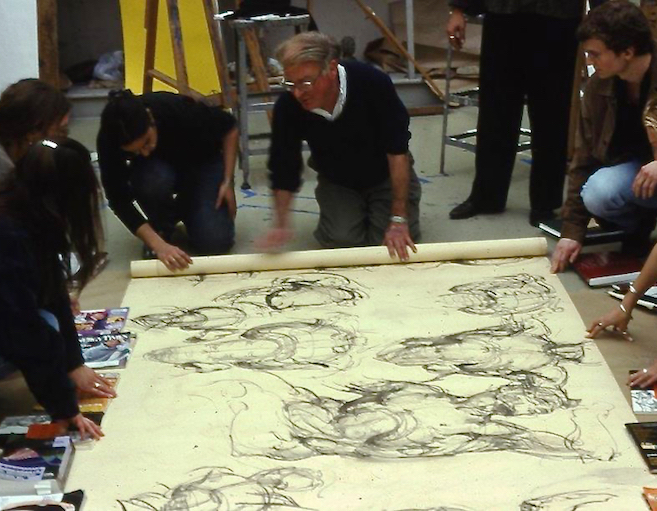
By virtue of its involvement with the Lyme Art Colony, the Art Students League of New York is inextricably connected to the history of Old Lyme, Connecticut. During the very height of the colony’s prominence, from 1902 to 1905, the League held immensely popular summer classes in Old Lyme. Thus, teachers and students associated with the League played a significant part in the area’s cultural life, and were integral in helping to establish the tradition of plein air painting and fine arts instruction that continues in Old Lyme today.
The Lyme Art Colony was the indirect product of a bicycle trip by Clark Voorhees, a native New Yorker and League student. Voorhees originally took to the area as a sportsman and naturalist, but he saw potential subjects in the hills, marshes, and river views of Old Lyme and began painting there in the summer of 1896. When he returned to New York City in the fall of that year he wrote in his diary, “I am sorry to get back after my long vacation, and feel more than ever that the country is the place for me.” A hundred years later I came to feel much the same way.
Voorhees was soon followed to Old Lyme by other artists, many of whom were fellow New Yorkers with ties to the League. They found the shoreline area of southeastern Connecticut an ideal place to relax and paint during the summer. Within a few years the Lyme contingency became the largest art colony in the country. The most prominent visiting artists were Henry Ward Ranger, who summered there from 1899 to 1904; Childe Hassam, from 1903 to ca. 1907, and Willard Metcalf, from 1905 to 1907. Central to the art life was a boarding house run by Florence Griswold—known as Miss Florence—which was the artists’ gathering place and, eventually, a museum celebrating the work of the colony.
Henry Ranger held sway in Old Lyme at the turn of the century, which is to say that a particular brand of Tonalism was prevalent. For Ranger, the woods and fields of Old Lyme were reminiscent of the French Barbizon Forest; perhaps he was on the lookout for just such a location, one upon which the French prototype could be easily transferred. In her monograph on Ranger, art historian Estelle Riback wrote, “The Barbizon idiom became the model for late nineteenth century landscape painters who strove for a personal expression.” In its depiction of a hushed forest clearing, dominated by an imposing oak and completed in the studio with layers of warm, rich glazes, Autumn Woodlands is a quintessential example of the vision that characterized the early years of the colony. Here was nature as a meditative haven.

This changed with the arrival of Impressionism, in the guise of Childe Hassam. Gone were the romantic overtones of Tonalism—disparagingly referred to as the “baked apple school”—replaced by an emphasis on prismatic color, a crisp plein-air handling and an absence of brown from the palette. Hassam’s The Ledges, October in Old Lyme presents a very different conception of the landscape, one in which the artist has apparently isolated a random fragment of nature. No single tree presents itself as a focal point; rather, a screen of thin trees is arranged parallel to the picture plane in a grid-like fashion. The real subject is sunlight and the high key color contrasts it produces. As if to symbolize the comparative brazenness of the new attitude, Hassam took to painting out of doors stripped to the waist. This must have been a truly pointed display at a time when landscape painters wore dress suits while working en plein air.

The colony had been served notice, and was predictably divided. Some painters, like Allen Butler Talcott, made their homes in Old Lyme and split the difference, incorporating both Tonalist and Impressionist modes in their painting. Ranger didn’t stay, and though he maintained amicable terms with Hassam, in 1904 he moved a few miles up the Connecticut coast. It was only after he’d left the colony that Ranger began to adopt a more impressionistic palette.
Of all the artists who joined the colony over the next few decades, my favorite is Willard Metcalf, who arrived in 1905 at the encouragement of Hassam. Metcalf’s three summers in Old Lyme produced both personal crisis and great success. In July 1907, the atmosphere in Miss Florence’s house was strained when Metcalf’s young wife ran off with one of his students, a painter named Robert Nisbet. However, in the same year his May Night, a painting of the front lawn and façade of Miss Florence’s home, was awarded a gold medal and purchased by the Corcoran Gallery in Washington DC. The event secured Metcalf’s reputation, and enriched the prestige of the Old Lyme colony. A writer in the Hartford Daily Courant noted:
Lyme cows are so busy posing for the Art classes that they have hardly time to be milked … One explanation of the remarkable jump Lyme has taken is that Willard Metcalf sold in three days $3,000 worth of Lyme landscapes in the St. Botolph Club last winter. This made Lyme landscapes sound like Standard Oil, and with no less enthusiasm than the gold hunters of ’49, the picture makers have chosen Lyme as a place in which to swarm.
The Florence Griswold Museum now houses the largest collection of Metcalf’s work and personal artifacts. His Kalmia, a painting of the ubiquitous mountain laurel that flanks the Lieutenant River, is one of the museum’s prizes.

Another New York painter who took up residence in Old Lyme was Frank Vincent DuMond. DuMond taught at the Art Students League for fifty years, and opened the Lyme Summer School of Art, which was the League’s satellite summer facility, in 1902. DuMond promoted the summer school hard, even sailing to France in an effort to convince expatriate American artists to return and study in Old Lyme. Describing the school’s curriculum, DuMond wrote,
“The study of landscape is always the great feature of interest in summer work. There are three criticisms weekly, two out of doors and one in the studio, covering all the work done during the week. These take the form of talks based upon the efforts submitted, the consideration of nature in its various phases, and meanings and its relationship to art and the needs of artists.”
“Unfortunately,” wrote art historian Richard H. Love, “in time, the permanent non-artist residents of Old Lyme became impatient with the constant intrusion on their privacies, and prices for lodging and food increased to the point that League students found it difficult to work there.” As well, some of the established artists wanted to keep Old Lyme for themselves, and resented the onrush of students. These tensions compelled the school to relocate to Woodstock, New York, in 1906. Nonetheless, DuMond had, according to Love, “put Old Lyme on the cultural map.” DuMond bought a home in Old Lyme, where he continued to teach privately, and would sometimes take a night ferry from New London to New York City to arrive in time to teach his morning classes at the League.
While some members of the Lyme Art Colony stayed in Old Lyme and made it their home, the best of the lot, Ranger, Hassam, and Metcalf, were in fact fair-weather residents who moved on after a few years. Hassam and Metcalf were friends, and their relatively brief convergence in Old Lyme had historical significance: many artists followed in their slipstream. Eventually, Voorhees voiced some reservations about art colonies:
At first they’re made up of a few good men. Then the floaters and hangers-on come in and spoil everything. It’s the social life that keeps those places going, and that saps your energy so that you can’t work. Some of the artists may accomplish something, but they’re the ones that would get ahead anywhere.
A century after Voorhees decided this would be a good place to set up shop, I came to Old Lyme as an itinerant artist and instructor of summer classes. I viewed the weekly trips from the New York City area as a necessary inconvenience. Others knew better: waiting in my mailbox at the Lyme Academy was a sheet of paper, with sketches of a half dozen good landscape sites and directions to each, that had been drawn up for me by Deane G. Keller. Unwittingly following the lead of legions of artists before me, by summer’s end I procured a studio in a nearby town and ceded the one I’d been sharing in Manhattan.

Many of the qualities that appealed to artists a hundred years ago are still in place. Although Old Lyme and environs are now easily accessed by I-95, the pastoral feel of the Connecticut River Valley endures in its wetlands, forests, and farmlands. The topography lends itself to painterly exploration; moreover, there are numerous sites far enough removed from the beaten path that one can set to work in relative, if not total, seclusion. I found this a welcome change from the urban plein air work I’d done in and around New York City, which entailed constant attentiveness to one’s surroundings and invited the curiosity of passersby, sometimes by the dozens. In Lyme and Old Lyme the local population pays little mind to the presence of landscape painters. This lack of distraction facilitates greater concentration on the work at hand, as well as a connection with nature. When I put my easel and a canvas in the back of my car, it’s with the intent to search out subjects which I can paint without interruption. The location of Beaver Pond is a private property in Lyme, just a few yards off a country road but secure from idle conversation. That of Barbizon Oak is a seldom-visited preserve behind the Old Lyme Inn and adjacent to I-95. Legend has it that Ranger painted this tree.
There are a lot of artists in the Old Lyme area today, but there’s no unified art colony to speak of. What exists are cultural institutions lining the town’s historic district of Lyme Street, and these, in addition to the area’s natural beauty, have insured something most unusual in a small town: the continued presence of artists and students. Within walking distance are the Lyme Art Association, incorporated in 1914 as a venue for representational art and life study with a fine gallery space; the Lyme Academy College of Fine Arts, which was originally conceived by the sculptor Elisabeth Gordon Chandler as an atelier school for those who sought to learn traditional methods of drawing, painting, and sculpture; and the Cooley Gallery, which presents exhibitions of contemporary artists as well as shows spotlighting some of the Lyme colonists; it was through Jeff Cooley that I first saw paintings by Allen Talcott, a seriously undervalued artist who painted memorable landscapes.

The cornerstone is still Miss Florence’s house, now the Florence Griswold Museum, which has blossomed under the direction of art historian Jeffrey Andersen. Acquisition of the Hartford Steam Boiler Inspection and Insurance Company’s paintings greatly enhanced the museum’s holdings, and necessitated the addition of the Krieble Gallery fronting the Lieutenant River, itself the subject of numerous paintings in the museum’s collection; the artists boarding at Miss Florence’s could eat breakfast and walk a few yards to the riverside to paint. Many times I’ve brought landscape painting classes to the site, or painted there on my own.
One cold and rainy January morning I visited the museum during off-hours, and was allowed into Miss Florence’s house by marketing director Tammi Flynn. Thanks to conscientious preservation, the building has retained much of its charm. On the first floor are the paneled walls and doors upon which the artists who stayed there painted; one of the panels, a collaboration between Hassam, Walter Griffin, and Henry Rankin Poore, is a fusion of Tonalist and Impressionist styles. This collection of informal paintings speaks to the collegial atmosphere that existed during the colony’s heyday.
On the second floor landing are three paintings, one each by Ranger, Hassam, and Metcalf. Ranger’s is Autumn Woodlands, the surface of which has acquired with time a mottled patina reminiscent of Albert Pinkham Ryder’s improvised canvases. The galleries of the second floor are devoted to paintings by members of the colony. While some of the paintings are picturesque in the mundane sense, there is beautiful work here painted in a style that was once deemed radical; it’s well to remember that only a few years before Hassam arrived in Old Lyme, New York critics dismissed his work as incomprehensible. In art the distinction between that which is revolutionary and that which is charming is astonishingly fugitive.
The best painters of the Lyme Art Colony produced enough timeless work to justify this fine museum, and to build a reputation that continues to draw artists to the area. In a second floor gallery there is a canvas by Everett Warner—another League student—of the winter sun shining on the Lieutenant River. The view from the museum’s grounds today is nearly identical to that which Warner observed when he painted behind Miss Florence’s boardinghouse. Suddenly time is rendered meaningless, and we’re reminded that what artists saw here a hundred years ago may still be seen today.



